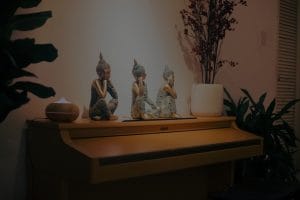**Abstract:**
Discover how to cultivate a serene sanctuary in your bedroom using Feng Shui principles. This guide offers practical solutions to enhance tranquility and promote inner peace.
Understanding Feng Shui and Its Benefits
Feng Shui, an ancient Chinese practice, focuses on harmonizing individuals with their surrounding environment. It emphasizes the flow of energy, or “chi,” and how it influences our well-being. By applying Feng Shui principles in your bedroom, you can create a space that fosters relaxation, rejuvenation, and inner peace. A well-organized and energetically balanced bedroom can significantly enhance your sleep quality, emotional health, and overall life satisfaction.
Choosing the Right Colors for Calmness
Color plays a vital role in establishing the mood of a space. In Feng Shui, soothing colors like soft blues, gentle greens, and muted earth tones are recommended for bedrooms. These hues evoke feelings of tranquility and serenity, creating a calming atmosphere conducive to restful sleep. Avoid bold colors or overly stimulating patterns, as they can disrupt the peaceful energy flow. Instead, opt for harmonious color palettes that invite relaxation and comfort.
Furniture Placement: The Key to Flowing Energy
The arrangement of furniture is crucial in Feng Shui. Position your bed in the “command position,” where you can see the door without being directly in line with it. This placement promotes a sense of security and control. Additionally, ensure that pathways are clear to allow chi to flow freely throughout the room. Avoid clutter, as it can trap negative energy and create a chaotic environment. A well-organized space encourages a tranquil mindset, essential for achieving inner peace.
Incorporating Natural Elements
Integrating natural elements into your bedroom can significantly enhance its energy. Consider adding plants, which not only purify the air but also bring a sense of vitality and connection to nature. Select low-maintenance plants like peace lilies or snake plants, which thrive in indoor environments. Additionally, incorporating natural materials such as wood, stone, or cotton in your decor can create a grounding effect, further promoting a serene ambiance.
Mindful Decor Choices for Serenity
When selecting decor items, choose those that evoke positive emotions and memories. Artwork depicting serene landscapes, calming images, or symbols of peace can enhance the room’s energy. Mirrors can be used strategically to reflect light and expand the space, but avoid placing them directly facing the bed, as this can create a sense of unease. Opt for soft lighting options, such as lamps with warm bulbs, to create a cozy and inviting atmosphere.
The Importance of Decluttering for Clarity
Decluttering is a fundamental aspect of Feng Shui that contributes to mental clarity and emotional balance. A clutter-free bedroom allows for a smoother flow of energy and reduces distractions that can interfere with relaxation. Regularly assess your belongings and remove items that no longer serve you. This practice not only enhances the physical space but also promotes a sense of emotional release and peace of mind.
Creating a Personal Sanctuary
Ultimately, your bedroom should reflect your personal tastes and preferences. Incorporate elements that resonate with you, whether it’s a cherished piece of art, a cozy throw blanket, or a favorite scent. Personalizing your space fosters a deeper connection to your environment, enhancing your sense of peace. Remember that achieving inner peace through Feng Shui is a personal journey, and your bedroom should be a sanctuary where you feel safe, relaxed, and rejuvenated.
By implementing these Feng Shui solutions, you can transform your bedroom into a tranquil haven that promotes inner peace and well-being. Embrace the power of your environment and let it support your journey toward serenity and balance.










